Frog Soup, Food for the Mind
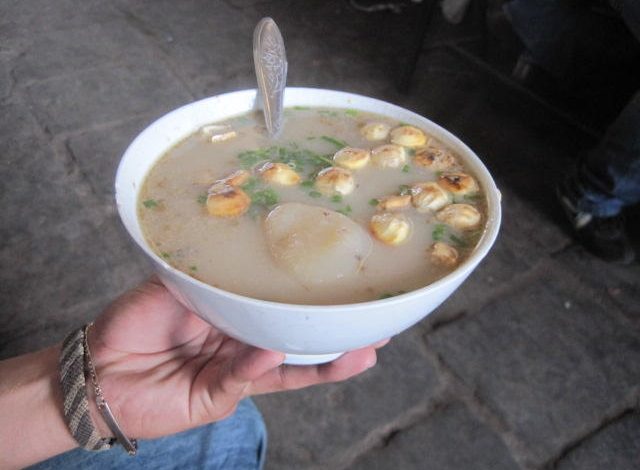
Just inside the bustling San Pedro Market, in front of the Machu Picchu Train Station, Mrs. Raida Valencia sits by a large mound of herbs, a pile of various cooked sea foods, and a plastic tub of frogs. She does not have to shout out at passersby to offer her food, they come to her and keep the seats in front of her booth occupied while spooning up her frog soup.
An intense woman with a lively smile and a fascinating story, Mrs. Valencia lifts a handful of squirming live frogs from the watery bin and explains.
“Frog soup is very good for the brain, especially for students who work hard and exhaust their minds. The frog soup gives them the energy and concentration to continue with their studies and succeed.
“We make the soup from many ingredients; each one brings an important health benefit to those who eat the soup.
“When I first began to make the soup it was just simple, frogs and green onions. But now we add much more.

“We use twelve ingredients. These include squid, octopus, crab, trout, and frogs. We also add something that used to go to waste but brings great vitality, bull’s penis. It brings the sexual and life vigor of a bull to the soup to help people.
“The butchers used to just throw away this part of the animal, but we buy them from them and cook them down with everything else to make the soup.
“We leave the soup to cook for hours, to concentrate the flavor, and then we sieve it so that people can eat the rich, savory broth with all these essences and it can provide them full benefit.
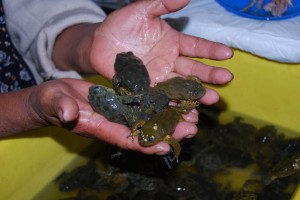
“They say the soup helps people revive after a heavy night of partying when they feel hung over. It is also good for strengthening ones eyesight, protecting the prostate, asthma, and menopause. It cures bronchial problems, nervous disorders, and is an aphrodisiac.”
Surprisingly for such a medicinal soup, it tastes good. It has the flavor of a concentrated and delicious sea food broth, what in Peru is called a chilcano. Like other sea food (or lake food) dishes, such as ceviche, frog soup is served with salted parched corn, called cancha. Not only does this give a contrast of crunch and salt, it also joins in a dualism the water world of the soup with the vital world of the earth and its symbolically significant food corn.
Mrs. Raida tells that when she was young she sold live frogs from buckets outside the market. They are brought from Bolivia regularly. Lake Titicaca, which sits on the border between Bolivia and Peru is famous for its giant frogs (telmatobius culeus). Wholesalers bring them to Cuzco and she would buy them and resell them. Now they bring them directly to her since her soup requires many, many frogs.
Frogs from the lake, most likely younger forms than the large adults of this lake Titicaca species, are harvested and marketed, though the species is in danger. Given the commercial importance of the frogs, both for this traditional market of smaller frogs, as well as the newer market in large frogs whose legs are sold in fine restaurants around the Lake and elsewhere, efforts are being made to develop a sustainable industry of frog production to protect the species, although they are still in their infancy.
Not only are the frogs argued to be nutritious, they are considered to have medicinal value. Part of their importance comes from their association with the lake itself. The highest large body of water in South America, Lake Titicaca sits on a high plateau called the Altiplano which is an internal drainage system. Its waters neither drain to the Pacific nor the Atlantic Oceans. As a result, since ancient pre-Inca times the lake has been considered holy. Like frogs, according to one myth, the first Inca themselves, Mama Ocllo and Manco Kapac, emerged from the earth on an island on the lake now called the Island of the Sun.
Small ears of corn grown on that Island were carried to granaries throughout the Empire, as if to take the fertility associated with the lake and this sacred island of origin to the entire space of the Andes, from contemporary Columbia to Chile, governed by the Incas.
Today, among other things, the frogs carry that meaning given their origin in the lake. While they might not be taken throughout the entire space of Peru, they certainly do arrive in Cuzco with the blessings of the lake’s waters and fertile healing for the people of Cuzco. Their origin is significant.
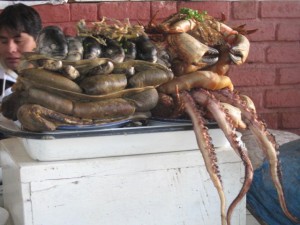
Señora Raida says that she began making the soup because students from lake-shore communities who were studying in Cuzco asked her to do so. They knew the value of the soup since the medicinal use of frogs was common in their communities near Lake Titicaca. In fact, students from the Department (state) of Puno came to Peru up until a university was opened in Puno in 1961, since until that time Cuzco’s historical San Antonio Abad university was the only university nearby where students could obtain higher education. Nevertheless, even after the National Technical University was opened in Puno a tradition of students from the altiplano studying in Cuzco continued.
Interestingly, the university students are a different group than the numbers of migrants who engage in commerce and settle in Cuzco. The two populations do not mix much in Cuzco, despite being from the same region. The soup, in Señora Raida’s story, is associated with the relatively high status university student, and not the mass of ordinary immigrants from the high Altiplano. This gives the soup a charge of social mobility and progress.
After that, according to Señora Raida, though she began making soup with just Frogs, later adding other ingredients, her soups have become popular with all university students to help them with the hard work of their studies which exhausts the brain, but with all Cuzqueños as well as other people.
“Tour guides brings tourists by, especially Italian tourists, to try the soup. They like it and it helps them with the problems that bother them. I also have nuts and dried fruit for tourists who do not want soup.
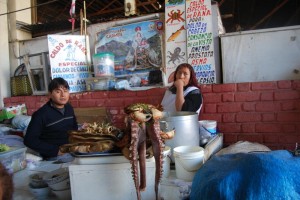
“Tell people they can find me if the come to the third door of the San Pedro Market, in front of the train station. If they come in that door the will find me. I am just down the row a little bit and they can see my sign “Caldo de rana”.
“Now, I am giving my business to my daughters. I have worked for many years, first selling frogs, then running a Peña [a Folklore night club], and then making and selling frog soup. The business has been good and with it I have raised my children. But they are now adults and so I am turning the business over to them. My daughter is now in charge.”
In Cuzco, food in general, is not only understood to be good for the stomach, but to have broader medicinal implications. And people evaluate it and its aesthetics in terms of curative properties and the relationship of people to the landscape and the cosmos.
In these terms, Mrs. Raida Valencia’s frog soup is a good example of a common property of Cuzco’s food. She invites you to come and taste her soup and see for yourself its value.
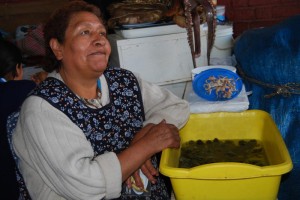





Good day! This is my first comment here so I just wanted to give a quick shout out and say I really enjoy reading through your articles. Can you suggest any other blogs/websites/forums that deal with the same topics? Thanks!